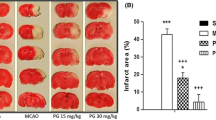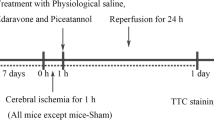Abstract
Stroke is a common neurodegenerative disease in the wide world, and mitochondrial defects underlie the pathogenesis of ischemia, especially during reperfusion. Picroside II, the principal active component of Picrorhiza, is a traditional Chinese medicine. Our previous study demonstrated that the best therapeutic dose and time window were injection of picroside II at a dose of 10–20 mg/kg body weight following cerebral ischemia by 1.5–2.0 h. In this paper, the neuroprotective effect and the mechanism of picroside II were investigated, as well as its involvement in antioxidant and mitochondria cytochrome C (CytC) signal pathway following ischemia reperfusion (I/R) injury in rats. After 24 h of cerebral I/R, the neurobehavioral function was measured by modified neurological severity score test; the content of reactive oxygen species in brain tissue was measured by enzyme-linked immunosorbent assay; the cerebral infarction volume was detected by TTC staining; the morphology of brain tissue was observed by hematoxylin-eosin; the apoptotic cells were counted by terminal deoxynucleotidyl transferase dUTP nick end labeling assay; the ultrastructure of the cortical brain tissues was observation by transmission electron microscopy; the expressions of CytC and Caspase-3 were determined by immunohistochemical assay and Western blot. The results indicated that picroside II could scavenge ROS contents, decrease the cerebral infarction volume and apoptotic cells, protect the structure of mitochondria, down-regulate the expression of CytC and Caspase-3 in cerebral I/R rats. It can be concluded that picroside II exerts a neuroprotective effect by inhibiting the mitochondria CytC signal pathway following ischemia reperfusion injury in rats.











Similar content being viewed by others
References
Borutaite V, Brown GC (2007) Mitochondrial regulation of caspase activation by cytochrome oxidase and tetramethylphenylenediamine via cytosolic cytochrome c redox state. J Biol Chem 282(43):31124–31130
Broussalis E, Killer M, McCoy M, Harrer A, Trinka E, Kraus J (2012) Current therapies in ischemic stroke. Part A. Recent developments in acute stroke treatment and in stroke prevention. Drug Discov Today 17(7–8):41–48
Cadena SGDL, Massieu L (2016) Caspases and their role in inflammation and ischemic neuronal death. Focus on caspase-12. Apoptosis 21(7):763–777
Chen J, Sanberg PR, Li Y, Wang L, Lu M, Willing AE, Sanchez-Ramos J, Chopp M (2001) Intravenous administration of human umbilical cord blood reduces behavioral deficits after stroke in rats. Stroke 32(11):2682–2688
Chen H, Song YS, Chan PH (2009) Inhibition of NADPH oxidase is neuroprotective after ischemia–reperfusion. J Cereb Blood Flow Metab 29(7):1262–1272
Doyle KP, Simon RP, Stenzel-Poore MP (2008) Mechanisms of ischemic brain damage. Neuropharmacol 55(55):310–318
Guo J, Duckles SP, Weiss JH, Li X, Krause DN (2012) 17β-estradiol prevents cell death and mitochondrial dysfunction by an estrogen receptor-dependent mechanism in astrocytes after oxygen–glucose deprivation/reperfusion. Free Radic Biol Med 52(11–12):2151–2160
Halestrap AP, Richardson AP (2015) The mitochondrial permeability transition: a current perspective on its identity and role in ischaemia/reperfusion injury. J Mol Cell Cardiol 78:129–141
Hinzman JM, Thomas TC, Quintero JE, Gerhardt GA, Lifshitz J (2012) Disruptions in the regulation of extracellular glutamate by neurons and glia in the rat striatum two days after diffuse brain injury. J Neurotrauma 29(6):1197–1208
Howells DW, Donnan GA (2010) Where will the next generation of stroke treatments come from? PLoS Med 7(3):91–92
Jing S, Qi L, Dong H, Song W, Xie K, Hou L, Xiong L (2012) Inhibition of mitochondrial permeability transition pore opening contributes to the neuroprotective effects of ischemic postconditioning in rats. Brain Res 1436(2):101–110
Kagan VE, Tyurin VA, Jiang J, Ritov VB, Amoscato AA, Osipov AN, Belikova NA, Kapralov AA, Kini V, Vlasova II, Zhao Q, Zou M, Di P, Svistunenko DA, Kurnikov IV, Borisenko GG (2005) Cytochrome c acts as a cardiolipinoxygenase required for release of proapototic factors. Nat Chem Biol 1(4):223–232
Kanno T, Nishizaki T (2011) Sphingosine induces apoptosis in hippocampal neurons and astrocytes by activating caspase-3/-9 via a mitochondrial pathway linked to SDK/14-3-3 protein/Bax/cytochrome c. J Cell Physiol 226(9):2329–2337
Kroemer G, Galluzzi L, Brenner C (2007) Mitochondrial membrane permeabilization in cell death. Physiol Rev 87(1):99–163
Laemmli UK (1970) Cleavage of structural proteins during the assembly of the head of bacteriophage T4. Nature 227(5259):680–685
Li P, Nijhawan D, Budihardjo I, Srinivasula SM, Ahmad M, Alnemri ES, Wang X (1997) Cytochrome c and dATP-dependent formation of Apaf-1/caspase-9 complex initiates an apoptotic protease cascade. Cell 91(4):479–489
Liu L, Wang D, Wong KS, Wang Y (2011) Stroke and stroke care in China: huge burden, significant workload, and a national priority. Stroke 42(12):3651–3654
Longa EZ, Weinstein PR, Carlson S, Cummins R (1989) Reversible middle cerebral artery occlusion without craniectomy in rats. Stroke 20(1):84–91
Mcllwain DR, Berger T, Mak TW (2015) Caspase functions in cell death and disease. Cold Spring Harp Perspect Biol 7(4):a026716
Min HM, Wang Y, Ren DY, Cheng X, Li J, Jiang XQ, Min LQ, Bao CF (2017) Protective effect of 2-deoxy-D-glucose on the brain tissue in rat cerebral ischemia-reperfusion models by inhibiting Caspase-apoptotic pathway. Histol Histopathol 32(1):57–67
Noritake K, Aki T, Funakoshi T, Unuma K, Nara A, Kato C, Uemura K (2012) Critical roles of Rho-associated kinase in membrane blebbing and mitochondrial pathway of apoptosis caused by 1-butanol. Toxicol in Vitro 26(6):849–855
Nunez-Figueredo Y, Ramirez-Sanchez J, Hansel G, Simoes Pires EN, Merino N, Valdes O, Delgado-Hernandez R, Parra AL, Ochoa-Rodriguez E, Verdecia-Reyes Y, Salbego C, Costa SL, Souza DO, Pardo-Andreu GL (2014) A novel multi-target ligand (JM-20) protects mitochondrial integrity, inhibits brain excitatory amino acid release and reduces cerebral ischemia injury in vitro and in vivo. Neuropharmacology 85(5):517–527
Oruc S, Gönül Y, Tunay K, Oruc OA, Bozkurt MF, Karavelioğlu E, Bağcıoğlu E, Coşkun KS, Celik S (2016) The antioxidant and antiapoptotic effects of crocin pretreatment on global cerebral ischemia reperfusion injury induced by four vessels occlusion in rats. Life Sci 154:79–86
Pei HT, Su X, Zhao L, Li HY, Guo YL, Zhang MZ (2012) Primary study for the therapeutic dose and time window of picroside II in treating cerebral ischemic injury in rats. Int J Mol Sci 13(2):2551–2562
Rodrigo R, Fernandez-Gajardo R, Gutierrez R, Matamala JM, Carrasco R, Miranda-Merchak A, Feuerhake W (2013) Oxidative stress and pathophysiology of ischemic stroke: novel therapeutic opportunities. CNS Neurol Disord Drug Targets 12(5):698–714
Sanderson TH, Kumar R, Sullivan JM, Krause GS (2008) Insulin blocks cytochrome c, release in the reperfused brain through PI3-K signaling and by promoting Bax/Bcl-XL, binding. J Neurochem 106(3):1248–1258
Sanderson TH, Reynolds CA, Kumar R, Przyklenk K, Huttemann M (2013) Molecular mechanisms of ischemia-reperfusion injury in brain: pivotal role of the mitochondrial membrane potential in reactive oxygen species generation. Mol Neurobiol 47(1):9–23
Sims NR, Anderson MF (2002) Mitochondrial contributions to tissue damage in stroke. Neurochem Int 40(6):511–526
Sousa CA, Soares EV (2014) Mitochondria are the main source and one of the targets of Pb (lead)-induced oxidative stress in the yeast Saccharomyces cerevisiae. Appl Microbiol Biotechnol 98(11):5153–5160
Wang TT, Zhai L, Zhang HY, Zhao L, Guo YL (2015a) Picroside II inhibits the MEK-ERK1/2-COX2 signal pathway to prevent cerebral ischemic injury in rats. J Mol Neurosci 57(3):335–351
Wang TT, Zhai L, Guo YL, Pei HT, Zhang MZ (2015b) Picroside II has a neuroprotective effect by inhibiting ERK1/2 activation after cerebral ischemic injury in rats. Clin Exp Pharmacol Physiol 42(7):930–939
Wei JW, Wang JG, Huang Y, Liu M, Wu Y, Wong LK, Cheng Y, Xu E, Yang Q, Arima H, Heeley EL, Anderson CS, ChinaQUEST Investigators (2010) Secondary prevention of ischemic stroke in urban China. Stroke 41(5):967–974
Acknowledgements
This work is supported by the National Natural Science Foundation of China (NSCF81274116).
Author information
Authors and Affiliations
Corresponding author
Ethics declarations
Conflict of Interest
The authors declare that they have no competing interests.
Rights and permissions
About this article
Cite this article
Zhang, H., Zhai, L., Wang, T. et al. Picroside II Exerts a Neuroprotective Effect by Inhibiting the Mitochondria Cytochrome C Signal Pathway Following Ischemia Reperfusion Injury in Rats. J Mol Neurosci 61, 267–278 (2017). https://doi.org/10.1007/s12031-016-0870-0
Received:
Accepted:
Published:
Issue Date:
DOI: https://doi.org/10.1007/s12031-016-0870-0




